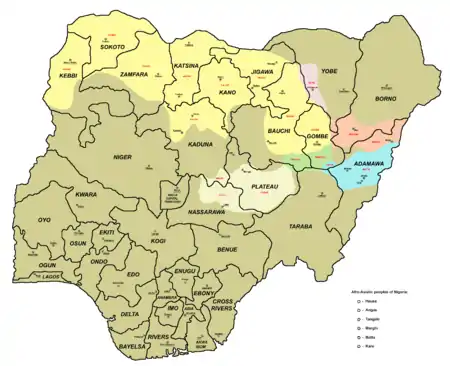Bole–Tangale languages
The Bole–Tangale languages (also known as the A.2 West Chadic languages) are a branch of West Chadic languages that are spoken in various states of northeastern Nigeria.
| Bole–Tangale | |
|---|---|
| A.2 West Chadic | |
| Geographic distribution | Bauchi, Yobe, Taraba, Gombe, Borno states of Nigeria |
| Linguistic classification | Afro-Asiatic
|
| Glottolog | west2715 |
 West Chadic per Newman (1977) | |

Main Chadic-speaking peoples in Nigeria
Languages
The Bole–Tangale languages are:[1]
Names and locations
Below is a comprehensive list of Bole–Tangale language names, populations, and locations from Blench (2019).[2]
| Language | Cluster | Dialects | Alternate spellings | Own name for language | Endonym(s) | Other names (location-based) | Other names for language | Exonym(s) | Speakers | Location(s) |
|---|---|---|---|---|---|---|---|---|---|---|
| Daza | Daza | a few villages (Note: No data available) | Bauchi State, Darazo LGA | |||||||
| Bole | Bara, Fika (Fiyankayen, Anpika) | Bòò Pìkkà, Bopika | Am Pìkkà, Ampika | Fika, Piika | Bolanci | Anika, Bolewa | 32,000 (1952 W&B); est. >100,000 (1990) | Bauchi State, Dukku, Alkaleri, and Darazo LGAs; Borno State, Fika LGA | ||
| Bure | BuBure | Bure | Bure | A single village southeast of Darazo town | Bauchi State, Darazo LGA | |||||
| Ɓeele | Bele | Àɓéelé | bòhé áɓéelé sg., Àɓéelé pl. | Bellawa | 120 (Temple 1922); a few villages | Bauchi State | ||||
| Deno | 9,900 (LA 1971) | Bauchi State, Darazo LGA; 45 km northeast of Bauchi town | ||||||||
| Galambu | Galembi, Galambe | Galambu | Galambu | 8505 (Temple 1922); 2020 (Meek 1925); 1000 (SIL) | Bauchi State, Bauchi LGA, at least 15 villages | |||||
| Dera | Shani, Shellen and Gasi | Bo Dera | na Dera sg., Dera pl. | Kanakuru | 11,300 (W&B) | Adamawa State, Shellen LGA; Borno State, Shani LGA | ||||
| Fyandigeri | Fyandigere | sg. laa Fyandigeri, pl. Fyandigeri | Gerawa, Gere, Gera | 13,300 (LA 1971); at least 30 villages. Many Gera villages no longer speak the language. A 2018 survey suggested there are only 4 villages where the language is being passed on to children. | Bauchi State, Bauchi and Darazo LGAs | |||||
| Geruma | Sum, Duurum, possibly Gamsawa/Gamshi (Temple) | Gerema, Germa | Geerum (Duurum dialect); Gyeermu (Sum dialect) | Geerum (Duurum dialect); sg. na Gyeermu, pl. Gyeermu (Sum dial.) | 4,700 (LA 1971) | Bauchi State, Toro and Darazo LGAs. At least 10 villages | ||||
| Giiwo | Kirifi | Bu Giiwo | sg. Ba Giiwo, pl. Ma Giiwo | 3,620 (1922 Temple); 14,000 (SIL) | Bauchi State, Alkaleri, Bauchi and Darazo LGAs, 24 villages | |||||
| Karekare | Western Jalalum, northern Pakaro and eastern Ngwajum | Kәrekәre, Kerekere, Karaikarai, Kerikeri | 39,000 (1952 W&B) | Bauchi State, Gamawa and Misau LGAs; Yobe State, Fika LGA | ||||||
| Kholok | Kode, Koode, Kwoode,Widala, Pia, Wurkum, Pitiko | 2,500 (1977 Voegelin & Voegelin) | Taraba State, Karim Lamido LGA, near Didango | |||||||
| Kubi | Kuba | 1,090 (1922 Temple); 500 (1973 SIL) | Bauchi State, Darazo LGA, 40 km. N.E. of Bauchi town | |||||||
| Kulung (Chadic) | Kulung (speakers consider themselves Kulung i.e. Jarawan Bantu, although their language is Chadic and related to Piya) | Wurkum | 2000? | Taraba State, Karim Lamido LGA | ||||||
| Kutto | Kupto | Kúttò | Kúttò | Two villages. 3000 (1990 est.) | Bauchi State, Bajoga LGA, Yobe State, Gujba LGA | |||||
| Maaka | Two dialects; Maaka (at Gulani) and Maha (at Vara) | Magha, Maga, Maha | More than 4,000 (1990) | Yobe State, Gujba LGA. Gulani and Bara towns and associated hamlets. Northeast of Dadin Kowa Reservoir. | ||||||
| Ngamo | Gamo | 17,800 (1952 W&B) | Borno State, Fika LGA; Bauchi State, Darazo LGA, Darazo district and Dukku LGA, Nafada district | |||||||
| Pero | Dialects associated with three major settlements | Walo | Péerò | sg. Péerò, pl. Pìpéerò | Filiya [town name] | 6,664 (1925 Meek); 20,000 (1973 SIL) | Gombe State, Shongom LGA, around Filiya. 3 main villages: Gwandum, Gundale and Filiya. | |||
| Piya–Kwonci cluster | Piya–Kwonci | Pia | Wurkum, Pitiko | 2,500 (1977 Voegelin & Voegelin) | Taraba State, Karim Lamido LGA, near Didango | |||||
| Piya | Piya–Kwonci | Pia | Wurkum | |||||||
| Kwonci | Piya–Kwonci | Kunshenu | More than 4000 (1990) | |||||||
| Goji | Fo Goji | Nya Goji pl. Memme Goji | Kushe, Kushi | Chong'e | 4000 (1973 SIL); 5000 (1990). ca. 20 villages (2007) | Gombe State, Shongom LGA | ||||
| Kwaami | Kafarati, Ɗolli | Kwami, Kwom | Kwáámì | Kwáámì | Komawa | 10,000 (1990) | Bauchi State, Kwami LGA | |||
| Nyam | Nyambolo | A single village | Taraba State, Karim Lamido LGA, at Andami village | |||||||
| Tangale | Ture, Kaltungo, Shongom, Billiri | Tangle | Táŋlɛ̀ | Billiri | 36,000 (1952 W&B); 100,000 (1973 SIL) | Gombe State, Kaltungo, Alkaleri and Akko LGAs |
References
- Blench, Roger. 2006. The Afro-Asiatic Languages: Classification and Reference List (ms)
- Blench, Roger (2019). An Atlas of Nigerian Languages (4th ed.). Cambridge: Kay Williamson Educational Foundation.
![]() This article incorporates text available under the CC BY 3.0 license.
This article incorporates text available under the CC BY 3.0 license.
External links
- The Yobe Languages Research Project by the late Russell G. Schuh of UCLA
- West Chadic resources at africanlanguages.org
This article is issued from Wikipedia. The text is licensed under Creative Commons - Attribution - Sharealike. Additional terms may apply for the media files.